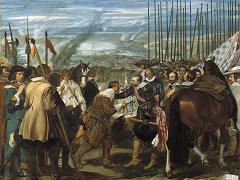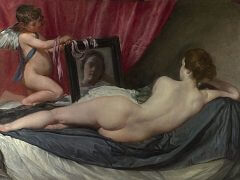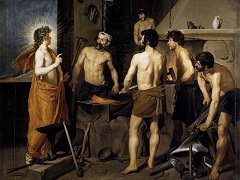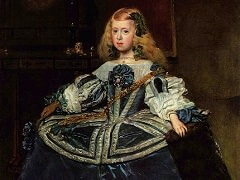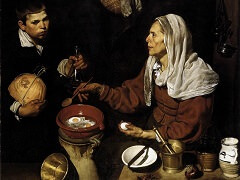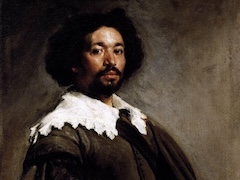The Spinners, 1657 by Diego Velázquez
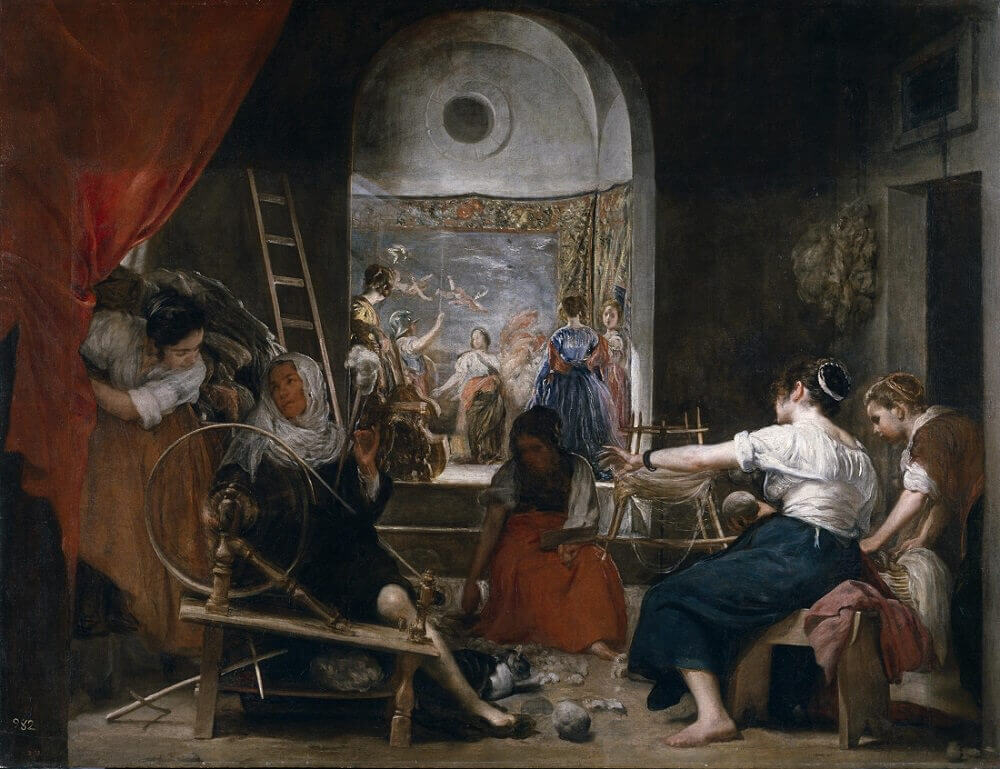
One of the most famous of the paintings by Velázquez, and an example of his great mythological works, is The Spinners, also known as The Fable of Arachne (Las Hilanderas). It was painted not for the king but for a private patron.
The mythological story of the contest between the goddess Athena (Minerva to the Romans) and the mortal woman Arachne was perhaps told best by the Roman poet Ovid in his Metamorphoses (Book VI). According to Ovid, Arachne lived in the country of Lydia (which had a legendary reputation for producing some of the most splendid textiles in the ancient world), where she matured into one of the finest weavers ever known. Arachne was in fact so adept at weaving that she became arrogant, and claimed that her ability rivaled that of the goddess Athena. Athena, as the patron deity of weavers and quite an accomplished weaver herself, immediately took notice of Arachne, and travelled to Lydia in order to confront the boastful woman. There the goddess assumed the guise of an old peasant, and gently warned Arachne not to compare her talents to those of an immortal; Arachne merely dismissed this reproach, and so Athena was compelled to accept the mortal woman's challenge.
They would each compete by creating a tapestry. Athena wove her tapestry with images that foretold the fate of humans who compared themselves with deities, while Arachne's weaving told of the loves of the gods. Such was Arachne's skill that her work equalled that of the goddess, and Athena, overwhelmed by anger, struck the hapless woman repeatedly. Terrified, Arachne hung herself, but Athena transformed the woman into a spider who quickly scurried off. Thus, this tale explains the spider's ability to weave its web.
In its composition, the artist looks back to his bodegones, where two different areas and two planes of reality balance each other. The everyday scene in the foreground shows a plainly furnished room where women are at work spinning. Sunlight falling in from above conjures up a complex range of colours. On the left, an elderly woman is at the spinning wheel, while the young woman seated to the right is winding yarn. One of the figures of naked youths by Michelangelo on the ceiling of the Sistine Chapel has been identified as the model for her attitude. Velázquez conveys their industry with brilliant immediacy, seeming to mingle the hum of their mills with the shifts of colour in the light. Three other women are bringing more wool and sorting through the remnants. The scene may reflect the disposition of the Royal Tapestry Factory of St Elizabeth in Madrid.
There is a second room in the background, in an alcove reached by steps. It is flooded with light and contains several elegantly dressed women. The woman on the left wearing an antique helmet and with her arm raised is a figure of Athena. Opposite her - either really in the room, or part of the picture in the tapestry on the back wall? - stands the young Arachne, who has committed the sacrilegious act of comparing her skill in weaving with the goddess's. She has begun their competition with a tapestry showing one of the love affairs of Jupiter, the rape of Europa. Velázquez borrowed the theme of this tapestry from a famous picture by Titian, also extant in a copy by Peter Paul Rubens, to show his artistic veneration for the Venetian master.
Velázquez's use of the curtain in this picture invoked a device that had been employed by a number of other Old Masters as a trompe-l'oeil way of drawing the viewer into the composition, pointing to the artifice of the scene, and also showcasing their own ability to paint something as lifelike as the drapery hanging in front of a picture; this was the case, for example, in The Art of Painting and The Girl with a Pearl Earring by Vermeer. Velázquez's play with the nature of the picture surface was given great scope by his use of similar devices, be it in the stage curtain of The Spinners.

